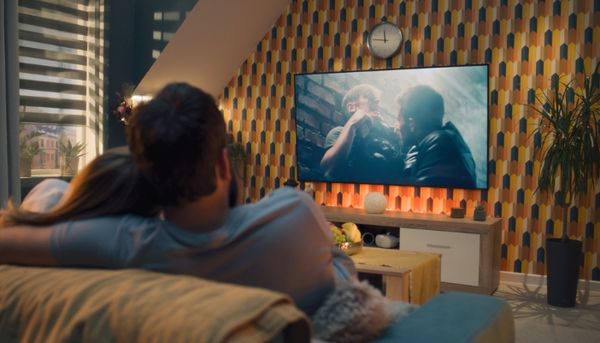
At A Glance:
What Is a Wireless Surround Sound System?
The Pros of Wireless Surround Sound Systems
The Cons of Wireless Surround Sound Systems
Practical Advice for Choosing Your System
The Verdict: Are wireless surround sound systems worth it?
Why Trust Total Home Technologies?
Imagine settling in for movie night lights dim, popcorn ready, anticipation building. The explosion on screen thunders from behind you, dialogue is crisp from the front, and subtle rustling surrounds your listening position. But here’s the game-changer: there’s hardly a wire in sight. Thanks to advances in technology, bringing home cinematic immersion with a wireless surround sound system has never been easier or more popular. Still, for thoughtful homeowners and tech enthusiasts, the big question remains—are wireless surround sound systems worth it?
If you're thinking about giving your living room or media den a sound upgrade, you’re not alone. Wireless systems have surged in popularity, but what’s the trade-off—and does it fit your space, budget, and expectations? This guide delves into the genuine pros and cons of today’s wireless home theater system options, offers actionable advice based on real-world scenarios, and helps you decide if now is the time to cut the cord.
Create the Perfect Home Audio System
Want to elevate your home audio experience? Work with the experts at Total Home Technologies in Austin, TX, for the best audio system advice and installation.
Home Audio UpgradesWhat Is a Wireless Surround Sound System?

A wireless surround sound system offers the audio immersion of a traditional 5.1, 7.1, or even Dolby Atmos setup but swaps out most, if not all, of the speaker cables for Wi-Fi, Bluetooth, or proprietary wireless connections. While “wireless” doesn’t literally mean “cord-free” (satellites and subwoofers still require power outlets), it makes installation radically simpler.
Most popular systems (think Sonos, Bose, Samsung, Vizio) send audio signals wirelessly from a core unit usually a soundbar, AV receiver, or control hub to connected wireless speakers and subwoofers. This means you can set up the magic of surround sound wireless with far less cable clutter and headache.
Learn more: The 8 Essential Components of Luxury Home Theaters
The Pros of Wireless Surround Sound Systems

1. Convenience and Simplicity: A Modern Solution for Busy Homes
One of the top reasons homeowners gravitate toward a wireless surround sound system is sheer convenience. Gone are the days of snaking wires under rugs, threading cords through walls, or painstakingly labeling cables.
Key advantages:
- Installation can typically be completed in under an hour—just place, plug, and pair.
- No need for specialized tools, cable fishing, or risky DIY modifications.
- Troubleshooting is often guided by companion apps, making self-setup much less intimidating.
Real-World Example:
Before a big holiday gathering, a busy family could purchase a new wireless home theater system. Instead of hiring an installer or fussing with cable runs, they unbox the kit, place the wireless speakers where they like, sync the system via a mobile app, and enjoy blockbuster sound long before the doorbell rings.
2. Sleek Aesthetics and Interior Design Friendliness
A wireless surround sound system is also the obvious choice for anyone who values a clean, modern look. Wires snaking across floors can spoil even the sharpest interior design. Wireless setups:
- Eliminate long cable runs across your living space.
- Allow speakers to be placed on shelves, consoles, stands, or even wall-mounted while keeping power cords hidden behind furniture.
- Remove trip hazards a big win for families with kids or pets.
Scenario:
A design-conscious couple in an industrial-style loft wants surround sound for their open living area but refuses to compromise on the minimalist look of exposed brick and steel. Wireless is the only way to achieve theater-grade immersion without a rat’s nest of cabling.
3. Flexibility For Any Room or Layout
Since sound is transmitted wirelessly, you’re free to experiment. Want to move your couch or add more seating? Rearranging is as easy as moving the wireless speakers no need to reroute cables or patch up old holes.
Other flexible options:
- Move speakers for parties, gaming, or different movie-watching spots.
- Reconfigure speaker placement if you move homes, upsize, or downsize.
- Start small, and upgrade over time by adding more satellites or zones a hallmark of modular wireless surround sound system ecosystems.
4. Multi-Room and Streaming Capabilities
Many leading wireless home theater system brands double as multi-room audio systems, letting you play music or TV audio throughout your house.
- Stream directly from Spotify, Apple Music, or Pandora to any room.
- Control everything from your smartphone or with your voice (Alexa, Google Assistant, Siri).
- Keep bedrooms quiet while the living room roars, all within the same brand ecosystem.
Pro Tip:
Sonos, Bose, and others allow seamless expansion start with a soundbar, then add surround satellites, a sub, or even outdoor wireless speakers when you're ready.
The Cons of Wireless Surround Sound Systems

1. Potential Latency and Audio Sync Challenges
A major technical challenge for any wireless surround sound system is ensuring crystal clear, precisely-timed sound. When audio is transmitted wirelessly, it can encounter latency meaning the sound you hear may lag slightly behind what you see on screen.
- Lip sync issues can be apparent, especially in fast action scenes or dialogue-driven programming.
- Increased latency is a particular concern for gamers or anyone using the system for video calls.
- Budget or older wireless systems are more prone to audio delays but high-end systems with WiSA or proprietary Wi-Fi Direct chipsets typically minimize this effect.
Gamers Beware:
Some users report a subtle (but frustrating) lag using wireless surrounds in competitive gaming or sports environments. Always check latency specs and read user reviews if instant response is a must for you.
2. Signal Interference and Dropouts
Because wireless audio relies on your home’s network or a proprietary signal, interference can occur, leading to audio hiccups, drops, or reduced quality.
- Wi-Fi congestion: Multiple smart devices, streaming, and network traffic can clog the airwaves, especially in dense apartments.
- Physical obstacles: Thick walls, metal furniture, or even microwaves may block or weaken signals.
- Distance limits: Most systems have a maximum recommended distance from hub to speaker performance drops if stretched too far.
Example:
If you live in a city apartment surrounded by dozens of Wi-Fi signals, you may experience occasional speaker cutouts or need to tweak your network placement for reliable performance.
3. Sound Quality Compromises vs. Wired Setups
A hot topic in the wireless vs wired surround sound debate is whether audio quality suffers when you cut the cords. In technical terms, wireless can struggle to deliver the same bandwidth and dynamic range as quality, wired analog cables, especially with high-res or lossless audio formats.
- Most wireless systems use audio compression, potentially reducing detail or dynamics.
- Wired systems generally provide more power and richer, deeper sound, especially for audiophile or custom home theater builds.
- However, today’s premium wireless options (like Sonos Arc or Bose Smart Soundbar with wireless surrounds) can come very close to wired fidelity for most listeners and are a quantum leap above any built-in TV sound.
Practical Take:
If you’re an audio perfectionist, wired remains king. For most music, movies, and TV, premium wireless surround sound system models get impressively close.
4. Power Not 100% Truly Wireless
While you won’t have speaker wires to hide, your wireless speakers and subwoofer will still need access to power. This can limit placement options or require creative furniture arrangement.
- Each surround speaker needs a plug; no major systems use battery-powered rear surrounds due to power demand and audio fidelity.
- In older homes or oddly-shaped living rooms, finding enough nearby outlets can mean using extension cords or power strips.
- Wall-mounting speakers still requires cord management for the power source.
5. Cost and Brand Ecosystem Lock-In
Freedom from wires comes at a premium:
- Quality wireless surround sound system setups typically cost more upfront than comparable wired systems.
- Expansion (adding more speakers, subwoofers, or rooms) can accumulate costs especially since many ecosystems only support their own brand’s hardware.
- Long-term, you may be dependent on manufacturer app updates, firmware support, and compatibility.
Example:
Expanding your Sonos-based surround system into additional rooms is easy and elegant, but every component comes at a premium and only works seamlessly inside that closed ecosystem.
Learn more: Austin's Top Home Automation Trends: What's Hot in Smart Home Tech
Which Users Will Benefit Most?
A wireless surround sound system is ideal for:
- Renters or homeowners who want a simple, non-invasive upgrade
- Households frequently re-arranging or redecorating
- Families with kids or pets that need wires kept out of sight
- Those prioritizing style, quick setup, and streaming features
But a traditional wired surround may be better for:
- Audiophiles and dedicated home theater builders seeking uncompromised performance
- Spaces with severe network interference
- Large, custom theaters where future expandability and ultimate fidelity are top priorities
Real-World Scenarios: Wireless Surround In Action
- Family Living Room: Parents want big-sound movie nights and the flexibility to move things for holidays. A wireless surround sound system can give them movie magic with zero trips or wire clutter.
- Audiophile Basement Theater: An enthusiast can build a Dolby Atmos system with in-wall wiring for every channel wired remains the gold standard for his immersive, reference-grade listening room.
- Urban Apartment: With thin walls and frequent moves, a renter can use a modular wireless home theater system for surround sound and music everywhere, taking it all easily to the next address.
Learn more: 10 Unexpected Ways Home Lighting Control Can Transform Your Living Space
Practical Advice for Choosing Your System

If you’re ready to go wireless for surround sound, keep these smart shopping and setup tips in mind:
- Map out where you’ll need power outlets for every speaker.
- Read latency and compatibility reviews, especially if gaming or audio-video sync is important.
- Double-check that your TV supports the system’s required connection (e.g., HDMI ARC/eARC).
- Prioritize upgradeable ecosystems can you add speakers later, or only buy in closed sets?
- If you struggle with Wi-Fi congestion, consider mesh networking, quality-of-service (QoS) settings, or placing your system components closer together.
The Verdict: Are wireless surround sound systems worth it?

In summary, are wireless surround sound systems worth it? For busy families, renters, redesigners, streaming enthusiasts, or anyone who wants immersive audio with minimal setup and visual clutter, the answer is an enthusiastic yes. With careful selection, the right system will provide years of reliable, impressive sound no electrician, drilling, or mess required.
However, if you’re building a reference-grade home cinema or are sensitive to every sonic detail, a traditional wired system is still unbeatable—at least for now. Contact Total Home Technologies today to explore entertainment options that fit your lifestyle and budget. We're here to make your home a smarter, more enjoyable place to live.
Frequently Asked Questions
It depends! For pure audio fidelity and ultra-reliable performance, wired is still the top choice, especially for dedicated theaters. For convenience, ease of installation, and aesthetics, a wireless surround sound system is usually superior for the average household.
In most cases, no a wired system still has the edge, particularly with high-resolution music or reference-quality movie mixes. That said, premium wireless home theater systems are remarkably close and better than any built-in TV sound.
Yes, and no. For casual movie watching or TV, yes—most users are thrilled with the experience. For competitive gaming or those with a critical ear, check product latency specs and avoid cheaper/budget systems.
Not quite you’ll be free of speaker wires between your TV and speakers, but each speaker still needs a power cord. The result: much less visible clutter, but not truly wire-free.
Why Trust Total Home Technologies
At Total Home Technologies, we are dedicated to turning your vision for a smart, connected home into reality. Specializing in the latest innovations in smart home automation, home theater design, advanced lighting control, motorized shades, outdoor entertainment, and more, we bring tailored solutions to enhance your lifestyle. Serving Austin, TX, and the surrounding areas, our experienced team combines cutting-edge technology with expert craftsmanship to deliver results that are both functional and stylish. Whether you're starting fresh with a new build or upgrading your current home, you can trust us to provide personalized guidance and solutions every step of the way. Together, we’ll create a home that perfectly balances sophistication, convenience, and comfort.
Shop Wireless Surround Sound Systems at Total Home Technologies
Choosing Total Home Technologies for your home speaker needs in Austin, TX, means partnering with a local team that truly understands the unique needs of the community. Our expertise, combined with a deep commitment to customer satisfaction, ensures that every solution is tailored specifically to your lifestyle. With a focus on quality, innovation, and seamless integration, we make it easy for you to enhance your home with advanced technologies designed to add convenience, energy efficiency, and modern style to your everyday life. Let us make your smart home vision a reality.